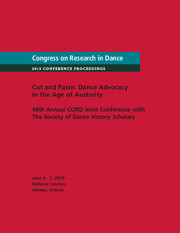Article contents
Dance Competition Culture and Capitalism
Published online by Cambridge University Press: 02 August 2016
Abstract
Long before So You Think You Can Dance and Dance Moms, dance competitions focused on tap, jazz, contemporary, and ballet were alive and well throughout the U.S. Since the 1970s, dance competitions have served as venues for dance students to display their skills as both a team and as individuals, and as a means of profit for the individuals and corporations who run them. Dance competition culture operates on a “pay to dance” framework and belief system. By some estimates, for competitors who are deeply involved in dance competitions, the costs can easily top $1,000 per month.
In many ways, more Americans are involved directly and indirectly in dance competitions than ever before, yet there has been little to no discussion of dance competition culture in relation to capitalism. The choice to participate in dance competitions affects the for-profit business models used in dance studios and is reflected in dance studios' tuition structures, required fees, and studio policies. Analyzing the economics of dance competition culture, which includes the organizations that offer dance competitions and dance conventions, the dance studios who train dancers for these events, and dance competition participants and their families, can provide valuable information about who has access to dance, and how that access reflects and shapes ideas about dance, gender, race, and class in the larger U.S. culture. As governmental support for dance continues to dwindle, it is timely to assess the financial, societal, and artistic impacts of increasing popularity of dance competition culture.
- Type
- Research Article
- Information
- Copyright
- Copyright © Karen Schupp 2016
References
Works Cited
- 1
- Cited by


